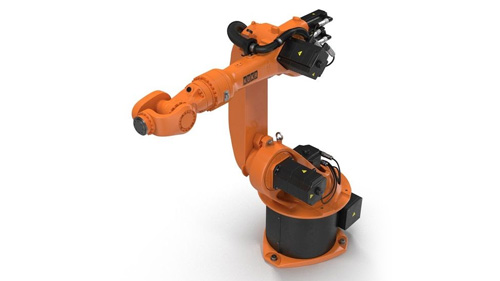Robotic arms are among the most advanced inventions in the last century. Automation has transformed the way manufacturing is carried out, and at the core of this revolution, robotic arms are doing the most.
There are different types of robotic arms, each designed to handle a specific type of work. We are going to explore how the conventional robotic arms operate, the mechanism behind them and how different parts combine to make one complete structure.
Parts of a Robotic Arm

Source: Pinterest
There are at least six components of industrial robots that work alongside each other to effect movement that is necessary for work to be done. These six parts are built independently but are controlled by a single program. They include the following.
Controllers: This is the brain of the robotic arm. It is the processor that holds the program that controls the entire robot. The program is created and fed into the controller by a technician, and depending on how advanced it may be, some processors like those on an EVS robot arm are autonomous. Once they are programmed, they handle the rest of the work on their own. Controllers can either be complex, like those found in heavy manufacturing, or they can be simple, like those found in joysticks.
Arms: These are the main sections of the robotic arm, and they take up the biggest space. A robotic arm is made up of three parts: a wrist, an elbow, and a shoulder. All these are designed as joints to allow some flexibility for the arm to move with freedom in any direction. It can go forward, backward, up, and down and it can even rotate and spin. Each of the three parts works in tandem with each other to ensure the machine is able to handle the tasks it was designed for.
End Effector: This is the part that resembles fingers, and in most cases, it comes in the form of two claws. It is the part of the robotic arm that takes care of the actual work by grabbing, pulling, lifting, and dropping. They open and close on command and can be very strong at times enough to lift very heavy loads bigger than the entire arm itself. End effectors have a high level of flexibility, and they can move in any direction and spin at the same time.
Drives: These are the motors that provide movement for every part of the robot arm. They are located in between the joints,, and they move independently of each other at varying speeds to propel the arm in any direction as dictated by the controller. They rely on belts to move parts as fast or as slow as needed.
Sensors: These are advanced parts of the robotic arm that are responsible for determining the space around the robot. Robotic sensors are able to detect if there’s an obstacle nearby and the information that they relay back to the controller is what allows the robotic arm to avoid collisions. This is how fast robotic arms are able to work alongside each other and people in close proximity without any accident occurring.
Servo-Mechanics and their Benefits

Source: Pinterest
Servo-mechanics refers to the process by which a robotic arm makes use of all the different parts to handle a task. Each robotic arm is denied differently but they all bring some unrivaled benefits to the table that include the following.
High-Torque Density: The movement needed to make a robotic arm fast, and super reactive has to be supported by advanced servo-motors that are fast. There is something called torque that is simply the sudden burst of energy to effect quick movements. It is very high in robotic arms, and this is what is behind the great efficiency of these machines in manufacturing.
Flexibility: All the parts of a robotic arm can move independently of each other in all directions, and this makes them a reliable force in the manufacturing space. The most advanced ones have up to 6 degrees of freedom and can turn a complete 360 degrees without snapping anything. This freedom is what makes them fast and versatile enough to be used in multiple tasks.
High-Precision Control: Combining speed and control is very hard for any machine, but this is exactly what robotic arms have perfected over the years of development. Robotic arms are controlled by cutting-edge programming that increases the speed without hurting precision. This is how they are able to handle complicated tasks at blinding speeds without getting anything wrong. The margins of errors are almost non-existent.
Programmable: Robotic arms are programmable, another asset that makes them very valuable. They are not fixed machines that can work in a fixed pattern. Changes can be made at any time, depending on the manufacturing needs. A pick and load robotic arm can be repurposed to a welding robot with a simple switch of the program, and it will pick up the pace like it has been doing that for years.
Durable: Robotic arms are built to last, and with the right maintenance, they can serve you for years, saving you the cost of having to hire people who will not even measure up to a single robotic arm. Each part of a robotic arm is built with the right materials that minimize damages, considering the number of moving parts. The guaranteed life-service of an average robotic arm is 35,000 hours of constant work. That’s more than enough time to make mad profits ten times over before replacing the robotic arm.
Safety: Contrary to popular belief, industrial robotic arms are the safest machines to have in your manufacturing plant. Thanks to advanced technology like sensors, they are able to make accurate split-second decisions based on prevailing conditions to prevent any form of collision. This is the reason why the number of accidents has dropped significantly in the manufacturing world since automation became the standard.
Conclusion
The mechanism behind the functioning of a robotic arm is getting complicated as time goes by as better technologies surface. We are not very far off from a future where automation will become fully integrated into every aspect of manufacturing to the point where robots will autonomously run everything. If you do wish to get your own robotic arm but are lost on which robot brands to go for, check out our website and get a few tips to help you with your search.
